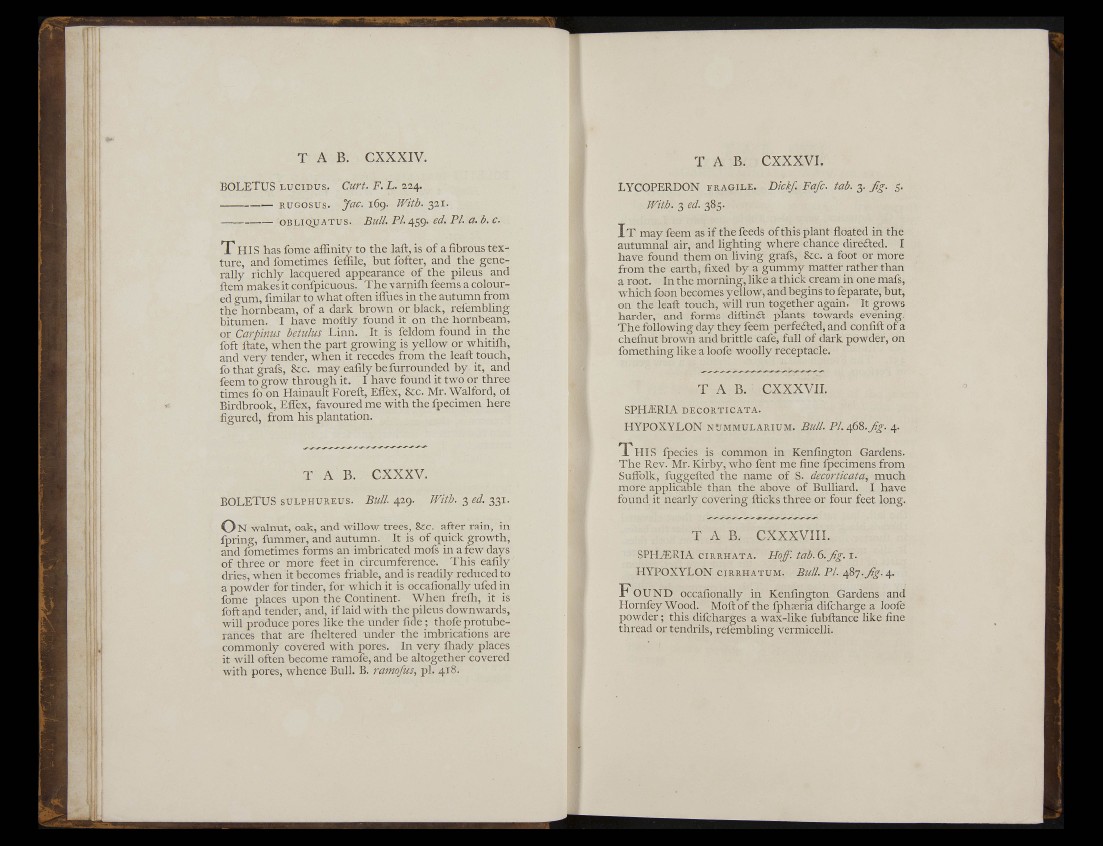
m
T A B . CXXXIV.
BOLETUS LUCiDUs. Curt. F, L. 224.
RUGOSUS. Jac. 169. JVitb. 321.
OBLIQUATUS. Bull PI 459. ed. PI. a. b. c.
X HIS has fome affinity to the laft, is of a fibrous texture,
and fometimes feifile, but fofter, and the generally
richly lacquered appearance of the pileus and
ftem makes it confpicuous. The arnifli feems a coloured
gum, fimilar to what often ifliies in the autumn from
the hornbeam, of a dark brown or black, refembling
bitumen. I have moftly found it on the hornbeam,
or Carpimis betulus Linn. It is feldom found in the
foft ftate, when the part growing is yellow or whitiili,
and very tender, when it recedes from the leafl: touch,
fo that grafs, &;c. may eafily be furrounded by it, and
feem to grow through it. I have found it two or three
times fo on Hainault Foreft, Efiex, &c. Mr. Walford, ol
Birdbrook, Efl'ex, favoured me with the fpecimen here
figured, from his plantation.
T A B. CXXXV.
BOLETUS SULPHUREUS. Bull. 429. With. 3 ed. 331.
O N walnut, oak, and willow trees, &c. after rain, in
fpring, fummer, and autumn. It is of quick growth,
and fometimes forms an imbricated mofs in a few days
of three or more feet in circumference. This eafily
dries, when it becomes friable, and is readily reduced to
a powder for tinder, for which it is occafionally ufed in
fome places upon the Continent. When frefli, it is
foft and tender, and, if laid with the pileus downwards,
will produce pores like the under fide ; thofe protuberances
that are fheltered under the imbrications are
commonly covered with pores. In very iliady places
it will often become ramofe, and be altogether covered
with pores, whence Bull. B. ramofus, pi. 418.
T A B. CXXXVI.
LYCOPERDON FRAGILE. Dickf. Fafc. tab. 3. fig. 5.
With. 3 ed. 385.
I T may feem as if the feeds of this plant floated in the
autumnal air, and lighting where chance direded. I
have found them on fiving grafs, &c. a foot or more
from the earth, fixed by a gummy matter rather than
a root. In the morning, like a thick cream in one mafs,
which foon becomes yellow, and begins to feparate, but,
on the leall: touch, will run together again. It grows
harder, and forms diflinft plants towards evening.
The following day they feem perfeiled, and confifl of a
chefnut brown and brittle cafe, full of dark powder, on
fomething like a loofe woolly receptacle.
T A B. CXXXVJI.
SPHiERIA DECORTICATA.
HYPOXYLON M'JMMULARIUM. Bull. PL fig. 4.
1 HIS fpecies is common in Kenfington Gardens.
The Rev. Mr. Kirby, who fent me fine fpecimens from
Suffolk, fuggefted the name of S. decorticata, much
more applicable than the above of Bulliard. I have
found it nearly covering flicks three or four feet long.
T A B.
cxxxvin.
Hoff. tab. 6. fig. I.
SPH^RIA CIRRHATA.
HYPOXYLON CIRRHATUM.
Bull. PL 487. fig. 4.
F O U N D occafionally in Kenfington Gardens and
Hornfey Wood. Mofl of the fphasria difcharge a loofe
powder ; this difcharges a wax-like fubftance like fine
thread or tendrils, refembling vermicelli.